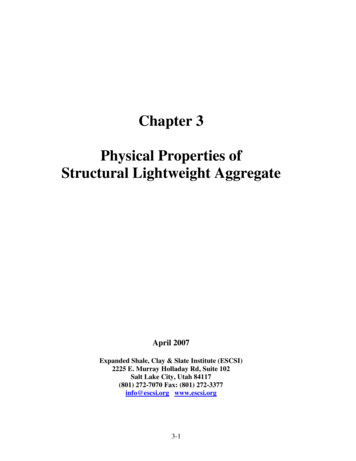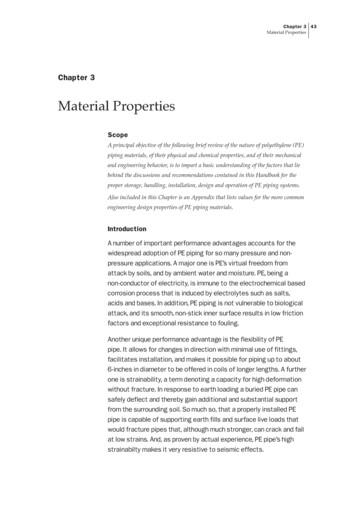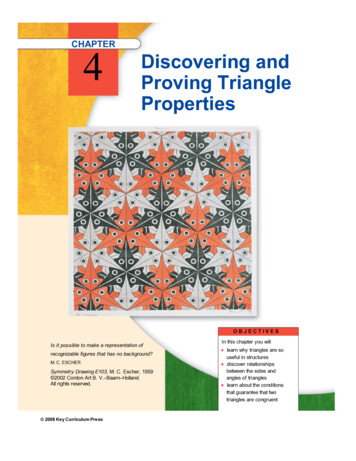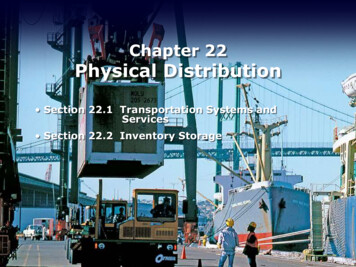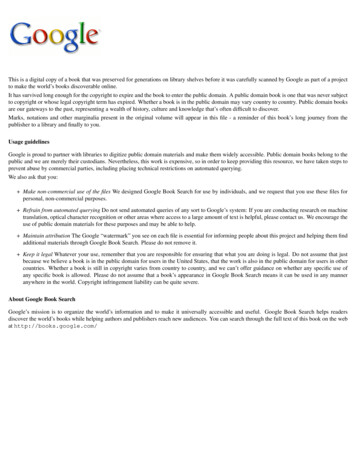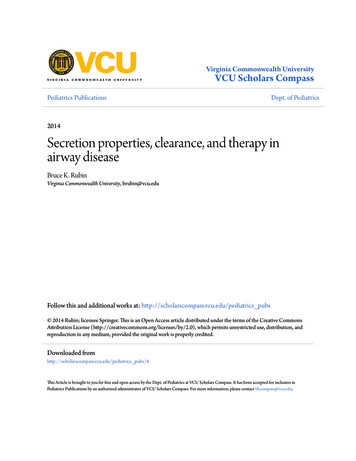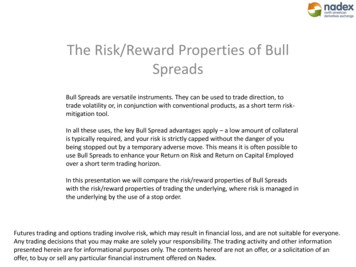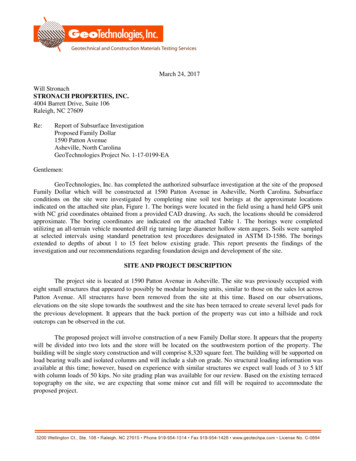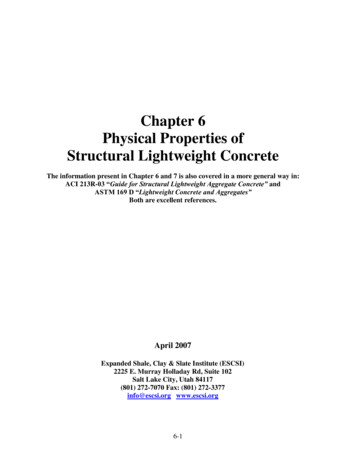
Transcription
Chapter 6Physical Properties ofStructural Lightweight ConcreteThe information present in Chapter 6 and 7 is also covered in a more general way in:ACI 213R-03 “Guide for Structural Lightweight Aggregate Concrete” andASTM 169 D “Lightweight Concrete and Aggregates”Both are excellent references.April 2007Expanded Shale, Clay & Slate Institute (ESCSI)2225 E. Murray Holladay Rd, Suite 102Salt Lake City, Utah 84117(801) 272-7070 Fax: (801) 272-3377info@escsi.org www.escsi.org6-1
CHAPTER 66.06.16.26.36.46.56.66.76.86.96.106.11Definition of TermsCompressive StrengthDensityDensity of the Constituents of Concrete Mixtures’Equilibrium Density-Self LoadsSpecified Density ConcreteAbsorptionInternal CuringIntroductionContact ZoneImplication of Contact Zone on Failure MechanismsPermeabilityPozzolanic CharacteristicsHistoryPozzolanic Terminology and PropertiesInfluence on Properties of ConcretePozzolanic Reaction in the Contact ZoneHeat Flow CharacteristicsThermal ConductivityLightweight ConcreteHigh Strength Lightweight ConcreteHigh Strength Specified Density ConcreteSpecific HeatThermal DiffusivityFire ResistanceGeneralHigh Strength Lightweight ConcreteHigh Strength Specified Density ConcreteRefractory ConcreteAbrasion ResistanceAppendix 6AAppendix 6BAppendix 6CAppendix 6DAppendix 6E―Standard Test Method for Determining Density of Structural LightweightConcrete”, ASTM C 567-05.“Jet Exhaust Damaged Concrete”, Hronaka and Malvar, ConcreteInternational, October 1998.Refractory Concrete PapersESCSI Publication #4362 ―Internal Curing Using Expanded Shale, Clayand Slate Lightweight Aggregate”.Chapter 46 ―Lightweight Concrete and Aggregates”, Significance of Testsand Properties of Concrete and Concrete-Making Materials, ASTMSpecial Technical Publication 169D.6-2
CHAPTER 6 PHYSICAL PROPERTIES OF STRUCTURALLIGHTWEIGHT CONCRETEThis chapter covers some of the physical properties of lightweight concrete. Theinformation is based on many laboratory studies and records of a large number ofexisting structures that have provided satisfactory service for more than 85 years.Typically, properties of lightweight concrete have been compared with those ofnormalweight concrete, and usually the comparison standard has been a singlenormalweight material. With several million cubic yards of lightweight concretebeing placed each year and the fact that normalweight concrete also has anintrinsic variability ; such a comparison of properties is no longer appropriate.6.0Definition of TermsConcrete, all lightweight-Concrete in which both the coarse- and fine-aggregatecomponents are lightweight aggregates. (Deprecated term-use preferred term;concrete, lightweight; concrete, structural lightweight; or concrete, specifieddensity.)Concrete, high-strength lightweight-Structural lightweight concrete with a 28day compressive strength of 6000 psi (40 MPa) or greater.Concrete, Insulating - Insulating concretes are very light non structuralconcretes, employed primarily for high thermal resistance, incorporate lowdensity low-strength aggregates such as vermiculite and perlite. With lowdensities, seldom exceeding 50 lb/ft³ (800 kg/m³), thermal resistance is high.These concretes are not intended to be exposed to the weather and generally havea compressive strength range from about 100 to 500 psi (0.69 to 6.89 MPa).Concrete, lightweight-See concrete, structural lightweight or specifieddensity.Concrete, normalweight- Concrete having a density of 140 to 155 lb/ft³ (2240 to2480 kg/m³) made with ordinary aggregates (sand, gravel, crushed stone).Concrete, sand lightweight-Concrete with coarse lightweight aggregate andnormalweight fine aggregate.Concrete, semi-lightweight-Concrete made with a combination of lightweightaggregates (expanded, clay, shale, slag or slate or sintered fly ash) andnormalweight aggregates having an equilibrium density of 105-120 lb/ft³ (16801920 kg/m³) (ACI 216).6-3
Concrete, specified density-Structural concrete having a specified equilibriumdensity between 50 to 140 lb/ft³ (800 to 2240 kg/m³) or greater than 155 lb/ft³(2480 kg/m³) (see concrete, normalweight). Specified density concrete (SDC)may consist as one type of aggregate or of a combination of lightweight andnormalweight aggregate. This concrete is project specific and should include adetailed mixture testing program and aggregate supplier involvement beforedesign.Concrete, structural/Insulating -Specifications that call for ―fill‖ concretesoften require compressive strengths and densities in the intermediate rangebetween structural and insulating concretes. These concretes may be producedwith high air mixtures and include structural lightweight aggregate, or sandedinsulating lightweight aggregate mixtures, or they may incorporate both structuraland insulating lightweight aggregates. Compressive strengths from 500 to 2500psi (3.4 to 17 MPa) are common with thermal resistance ranging betweeninsulating and structural concrete.Concrete, structural lightweight-Structural lightweight-aggregate concretemade with structural lightweight aggregate as defined in ASTM C 330. Theconcrete has a minimum 28-day compressive strength of 2500 psi (17 MPa), anequilibrium density between 70 and 120 lb/ft³ (1120 and 1920 kg/m³), andconsists entirely of lightweight aggregate or a combination of lightweight andnormal-density aggregate.Structural lightweight concretes generally contain aggregates made frompyroprocessed shale’s, clays, slates, expanded slags, expanded fly ash, and thosemined from natural porous volcanic sources. Structural lightweight concrete isnormally classified by a minimum compressive strength that was jointlyestablished by the ASTM Specification C 330 for Lightweight Aggregates and theStandard Building Code for Reinforced Concrete (ACI 318). The 318 codedefinition is ―Structural concrete made with lightweight aggregate; theequilibrium density at 28 days is usually in the range of 90 to 115 lb/ft³ (1440 to1850 kg/m³) and the compressive strength is more than 2500 psi (17.2 MPa)‖.This is a definition, not a specification and project requirements may permitequilibrium densities up to 120 lb/ft³ (1900 kg/m³), most lightweight aggregateconcrete used in structures have equilibrium unit weights between 100 and 115lb/ft³ (1600 to 1792 kg/m³).These definitions are not specifications. Project specifications vary. Whilelightweight concrete with an equilibrium density of 70 to 105 lb/ft³ (1120 to 1680kg/m³) is infrequently used, most lightweight concrete has an equilibrium densityof 105 to 120 lb/ft³ (1680 to 1920 kg/m³). Because lightweight concrete is oftenproject-specific, contacting the aggregate supplier before project design is advisedto ensure an economical mixture and to establish the available range of densityand strength.6-4
Contact zone-The expression ―contact zone‖ includes two distinctly differentphenomena (1) the mechanical adhesion of the cementitious matrix to the surfaceof the aggregate and (2) the variation of physical and chemical characteristics ofthe transition layer of the cementitious matrix close to the aggregate particle.Curing, internal-Internal curing refers to the process by which the hydration ofcementitious materials continues because of the availability of absorbed waterwithin the pores of the lightweight aggregate particle.Density, equilibrium-As defined in ASTM 567, it is the density reached bystructural lightweight concrete (low density) after exposure to relative humidity of50 5% and a temperature of 73.5 3.5ºF (23 2 ºC) for a period of timesufficient to reach a density that changes less than 0.5% in a period of 28 days.Density, oven dry-As defined in ASTM C 567, the density reached by structurallightweight concrete after being placed in a drying oven at 230 9ºF (110 5ºC)for a period of time sufficient to reach a density that changes less than 0.5% in aperiod of 24 hr.Lightweight-The generic name of a group of aggregates having a relative densitylower than normal-density aggregates. The generic name of concrete or concreteproducts having lower densities than normalweight concrete products.Lightweight aggregate concretes are broadly divided by ASTM into three groupsbased upon their use and physical properties, structural, structural/insulating andinsulating concrete density, thermal conductivity and compressive strength rangesnormally associated with each class of concrete are summarized in Table 6.1.TABLE 6.1—Lightweight Aggregate Concrete Classified According to Use and PhysicalProperties according to ASTM C 330 and C 332.Class of LightweightAggregate ype of LightweightAggregate used inConcreteTypical Range ofLightweight ConcreteDensity lb/ft³ (kg/m³ )Structural-grade LWA 90 to 115 (1440 to 1840)C 330at equilibriumEither structural C 330 45 to 90 (720 to 1440)or insulating C 332 orat equilibriuma combination of C330 and C 332Insulating-grade LWA15 to 50 (240 to 800)C 332oven dry6-5Typical Range ofCompressive StrengthPsi (MPa) 2500 ( 17)Typical Range of ThermalConductivitiesBtu · in./h · ft2 · F (W/m K).not specified in C 330500 to 2500 (3.4 to 17) C 332 from 0.15 (1.05) to3.00 (0.43) oven dry100 to 500 (0.7 to 3.4)C 332 from 0.45 (0.065)1.50 (0.22) oven dry
6.1Compressive Strength―Compressive strength levels commonly required by the construction industry fordesign strengths of cast-in-place, precast, or prestressed concrete areeconomically obtained with lightweight concrete (Shideler 1957; Hanson 1964;Holm 1980a). Design strengths of 3,000 to 5,000 psi (21 to 35 MPa) arecommon. In precast and prestressing plants, design strengths above 5,000 psi (35MPa) are usual. In several civil structures, such as the Heidrun Platform andNorwegian bridges, concrete cube strengths of 8700 psi (60 MPa) have beenspecified (fib 2000). All aggregates have strength ceilings, and with lightweightaggregates, the strength ceiling generally can be increased by reducing themaximum size of the coarse aggregate. As with normalweight concrete, waterreducing plasticizing and mineral admixtures are frequently used with lightweightconcrete mixtures to increase strength and workability as well as to facilitateplacing and finishing‖. ACI 213R-03.6.2DensityThe fresh density of lightweight concretes is a function of mixture proportions, aircontents, water demand, particle density, and moisture content of the lightweightaggregate. Decrease in density of exposed concrete is due to moisture loss that, inturn, is a function of ambient conditions and surface area/volume ratio of themember. Design professionals should specify a maximum fresh density forlightweight concrete, as limits for acceptability that should be controlled at timeof placement. The design professional needs to work with the LWA supplier toestablish a correlation between fresh density and equilibrium density (self-loadused for design).―Although there are numerous structural applications of lightweight concreteusing both lightweight coarse and lightweight fine aggregate, usual commercialpractice in North America is to design concrete with natural sand fine aggregates.Long-span bridges using concretes with three-way blends (coarse and finelightweight aggregates and small supplemental natural sand volumes) haveprovided long-term durability and structural efficiency (density/strength ratios)(Holm and Bremner 1990). Earlier research reports (Kluge, Sparks, and Tuma1949; Price and Cordon 1949; Reichard 1964; Shideler 1957) compared concretecontaining both fine and coarse LWA with ―reference‖ normalweight concrete,while later studies (Hanson 1964, Pfeiffer 1967) supplemented the early findingswith data on lightweight concrete where the fine aggregate was natural sand‖,ACI 231R-03.Despite the ACI 213 definition of structural-grade lightweight concrete that hasan equilibrium dry density ranging between 90 to 115 lb/ft³ (1,440 and 1,850kg/m³), the report also adds that ―it should be understood that this definition is nota specification. Job specifications may, at times, allow density up to 120 lb/ft³(1,900 kg/m³). In the majority of applications in North America, HSLC has been6-6
associated with equilibrium densities of about 115 lb/ft³ (1850 kg/m³) and, insome cases, as much as 120 lb/ft³ (1,900 kg/m³).Density of the Constituents of Concrete MixturesThe equilibrium density of lightweight concrete is determined by the relativedensity of the aggregates (lightweight and normalweight) and the density of thecementitious matrix. The relative density of the lightweight aggregates typicallyrange from 1.1 to 1.3 is covered in Chapter three. The relative density of the localnormalweight aggregates are usually well established, with the common practiceof assuring a value of 2.65 unless otherwise determined.Surprisingly, even though the relative density of cement is typically 3.15 therelative density of the hardened cementitious matrix fraction (referred to as thehydrated cement paste HCP) of concrete is quite low and closer to that oflightweight aggregates then that of any normalweight aggregates used.Normalweight aggregate is the heaviest component in concrete.The relative density of the cementitious fraction is best observed in the followingsimplistic example shown below in Table 6.2 and Fig. 6.1:Table 6.2. Density of Hydrated Cement Paste (HCP)Assume a w/cm 0.5 and Non-Air Entrained ConcreteRelative DensityFresh WetWeightAbsoluteVolumeHCP 01.50.821.2TotalsDensity fresh HCP 1.5 1.83 (114 pcf)0.82Density oven dry 1.2 1.46 (91 pcf)0.82Density, air dry @ 8% Moisture Content 1.46 x 1.08 1.58 (98 pcf)The relative density of the HCP fraction is further reduced by the voids developedby entrapped and deliberately entrained air as shown below in Fig. 6.1.Assume an air entrained concrete at 6%. When the coarse aggregate is removedthe remaining mortar changes to having a 9% air entrained and when the fineaggregate is removed the remaining
made with structural lightweight aggregate as defined in ASTM C 330. The concrete has a minimum 28-day compressive strength of 2500 psi (17 MPa), an equilibrium density between 70 and 120 lb/ft³ (1120 and 1920 kg/m³), and consists entirely of lightweight aggregate or a combination of lightweight and
